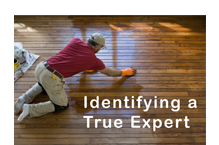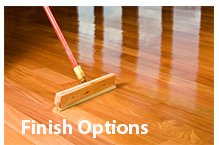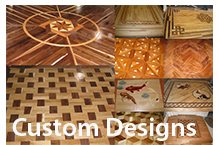The 9 Hardwood Floor Myths
- Myth #1
- Myth #2
- Myth #3
- Myth #4
- Myth #5
- Myth #6
- Myth #7
- Myth #8
- Myth #9
I can probably refinish
my own floors...
You probably can. What outcome are you expecting though? How much time do you have on your hands? Do you value your marriage?
Seriously though, your first challenge is going to be with the rental equipment. Rental store floor sanding equipment is just nowhere near the same level as the heavy duty, industrial tools that a professional floor sander has at his disposal. Our equipment is balanced and meticulously maintained, which is more than one can say for most rental equipment.
If you called up a dozen seasoned professionals and asked them to refinish a floor with rental equipment, I guarantee most, if not all, would refuse. Our skill level would be negated in part by the performance of the rental equipment.
In the hands of a “newbie” or someone inexperienced, you can imagine what the results would be. One almost invariably ends up damaging the floor and greatly reducing its wear layer and life. Some courageous souls do go ahead and attempt to sand their floors. Some do have “fair results,” often not knowing that they have significantly reduced the life of the floor by removing more than they should have. Would you call that saving? Often we are called in to “save a marriage” by a frustrated and fearful husband who thought he could rent some equipment and do his own floor. Believe us, you don’t want to be in that position!
The next challenge, even if you do succeed in sanding your floors to the bare wood and you’re satisfied with the results, is the application of the finish. Most storebought finishes are relatively easy to apply. An industrial finish that will guarantee long-lasting results is simply unavailable to the public. These finishes cannot be bought in retail stores. They’re far too challenging to apply to let the public have access to them without training. Can you imagine the call-backs and angry customers they’d have to deal with when customers ruined their floors?
On top of that, how long do you want to inconvenience your family? Without the right tools - which can cost professionals up to $60,000 - it could take days or even weeks to complete, and still you’d be left with an unsatisfactory finish that you’ll be reminded of every time you glance down at the floor. In addition, rental equipment does not come with a full dustless system. There are often “clouds” of dust to be reckoned with.
So yes, you can refinish your own floors, BUT... you can’t say we haven’t warned you!Finishes on Pre-finished flooring are
harder than site-applied finishes...
Most pre-finished hardwood flooring comes with a factory-applied finish that is cured by ultra violet light in controlled environments. Most of the higher end pre-finished flooring manufacturers will apply up to seven thin coats, some with additives for extra durability such as aluminum oxides. These extremely fine coatings are most often sprayed on. Following the applications, they are cured with UV lighting. The end result is an extremely hard finish often guaranteed for 15-30 year of normal use (with of course all the small print included that limits the real-life terms of the guarantee).
Over the years, we’ve had to refinish many solid pre-finished floors with factory UV cured finish. Yes they still wear, despite what their marketing may say. Site-finished floors and pre-finished floors both require the same maintenance and care to make them last. Pre-finished flooring manufacturers like to oversell their product's ability, while finish manufacturers like to be more realistic regarding their products performance.
We’ve seen site-finished floors 10 years old still looking brand new, and we’ve seen 3-year-old pre-finished flooring looking 20 years old. Please read our article on site-finished or pre-finished for more informationThe best quality finish will prevent
my floors from denting...
Floor finishes, no matter how strong, will not prevent a hardwood floor from denting because they simply are not designed to. One must understand the difference between "impact resistance" and "wear resistance."
Floor finishes are formulated to resist wear. The density of the wood itself is the key to a dent-resistant floor. For example, maple, oak, fir, and Brazilian cherry all resist impact to different degrees. Given the fact that virtually all wood used for flooring can and will dent, you want to use a high-quality floor finish that will yield and flex when subjected to impact, still retaining a “seal” of finish where the impact occurs. Let’s face it, we all drop something on our floors sometime or another.A high-quality finish
will not scratch...
This myth is common because of the “smart” marketing of some pre-finished flooring companies. They found out that if they guarantee this, they’ll sell more product and not many consumers will bother with their very limited, qualified (abundant fine print) guarantee. Smart for them? Maybe.
Realistically though... dragging a sharp, metal-tipped object while applying significant weight across a floor surface will scratch any given finish, no matter how hard the finish. Even a porcelain floor tile will scratch when subjected to such pressure. This though is not what floors are normally subjected to.
A professionally refinished hardwood floor should hold up very well under normal foot traffic - even if you’re an active family with pets. Over the years the “high traffic” areas may show a change of sheen but this does not necessarily mean that the finish is near to being worn through.
One will always see in direct sunlight over time what we call “micro abrasion.” These are very fine abrasions to the top surface of the finish. Virtually all floors will show signs of this as we live and walk on them no matter the quality of the finish. This is to be expected.
Lifestyles vary. There are home settings where large, energetic dogs have free reign to run around. Maybe your family is like this. Others may have a family member who is wheelchair bound or one who uses a walker or crutches. Or maybe your family doesn’t take their shoes off inside your home - and this is fine. Your hardwood floor contractor should query you on your lifestyle prior to recommending a finish so he can match one to properly suit your needs. This is a sure sign of a professional.Applying as many heavy coats of finish
as possible is best...
This is a common misconception. The number of finish coats that is recommended to apply is approximately three to four. This includes most often a “sealer” coat and three to four finish coats. All coatings should be evenly applied to their recommended coverage rates. This will ensure proper drying and lifelong adhesion between coats.
Excessive top coatings tend to give the floor a look as if it were plastic or artificial. It also must be said in the case of solvent-based finishes, which yellow over time, that the appearance of the wood grain becomes obliterated. Many times we have difficulty determining a wood species given the fact that the numerous coatings applied to it years prior have taken on the look of a painted surface.
The real secret is to choose from among the highest quality floor finishes available. These are offered only through your professional floor restorer. They will remain clear and show the rich grain patterns of the natural wood flooring. Then, have these professionally applied in a controlled setting.Water-based finish is not as durable
as oil based finish...
This is definitely not correct anymore. Years ago, when were were starting in the business, this was the case for a number of water-base finishes. Homeowners and contractors alike wanted finishes that were less offensive to the environment and the home setting. Basically, they didn’t want to live with the offensive oil-based smell and fumes. Floor refinishers led the quest for a finish that was less hazardous to their health.
Responding to market demand, lines of “finish systems” were introduced at the retail level that were what we call “waterborne” coatings. This means that traditional finishes were modified so that the vehicles carrying the resins were not toxic solvents and alcohols, simply water. But... the quality and durability of these “new” finishes offered at the retail level just couldn’t compare with the traditional and extremely durable, “Glitsa” Swedish finishes nor the “moisture cure” lines applied at the professional level.
Makers of professional floor finishes turned their attention to producing “waterborne” coatings that would match and exceed traditional applications. Well, jump forward a decade or so and floor finish companies have now made amazing advancements in their waterbased formulas. Companies such as “Pallmann” have formulated top-of-the-line two-component finishes that by far surpass your basic oil modified polyurethanes in terms of wear resistance.
If you’re looking for the most durable hardwood floor finishes on the market today and want the advantage of minimal fumes and smell, then these new finish systems are what you’re looking for.Gloss finish is harder
than satin...
This may have been true many years ago near the turn of the century. The science of formulating floor finishes has made great advances in recent decades, and the difference now is so minute that it’s no longer true.
Again, what makes the difference is making sure you use industrial quality finishes on your floor. If you’re investing all that time and money into your floors, you want to make sure you’ll get many, many years of enjoyment out of them.
What you need is to steer clear of are the finishes often offered in the larger retail stores. These are specially formulated to be applied by virtually any one with little or no experience and still turn out quite good looking. Their durability in the long run is what you sacrifice for easy application. The retail finishes cannot be compared to the finishes your professional hardwood floor restorer will apply.
Finishing techniques and tools at the “professional level” are also very different from what you may commonly see in big box stores, and they can take many years of use to master in order to consistently produce professional, quality results. These finishes and tools cannot be purchased at the retail level.I should regularly wax
my hardwood floors...
WOW, it’s hard to believe this one is still out there making the rounds. This was the case a long, long, time ago.
Quality floor finishes applied by a professional do not need waxing. Doing so can be hazardous because it can make the floor slippery. And if you do wax your floors, you’ll never be able to re-coat them if you wish or need to at a future date. The existing wax will prevent the newly applied finish from adhering properly. Removing years of old wax entirely from off a floor surface is virtually impossible short of sanding the floor down to the bare wood.A stain can be put in the finish
to give color to the floor...
Not successfully. You may have seen products in your local large retail store that boast this capability. In fact, such is the confusion that your average homeowner will often refer to the finish as “stain”. Many believe that you choose the color of floor finish to apply. This is not so. All floor finishes are clear and dry clear. Stain is a wood dye, or coloring.
Mixing the two is not the recommended way to stain a floor. A floor is properly sanded down to the bare wood, meticulously prepared, and then a color of choice is applied. After that dries and cures, clear topcoats seal and protect the floor. This is the recommended and approved method of staining a floor.
Mixing stain into the finish compromises the integrity of the finish itself and this will most often void the warranty provided by the supplier.
From time to time, we still see this attempted even by some professionals. Doing so tends to obliterate the beautiful wood grain, masking its natural beauty. Most often we have found that this becomes a desperate last-minute solution for some to mask a poorly refinished hardwood floor.
You may have heard that this is a common practice in the cabinetry industry. Yes it is, and it’s very successfully and produces beautiful results. The purposes are different, as are the application methods. BUT... remember, you do not walk on cabinetry! Often an inferior grading of wood can be masked to look “high end”. For example, maple can be made to look like cherry. Hevia, commonly called rubber wood, can be stained to resemble mahogany.
CONCLUSION :
Being well-informed is not only a protection but is refreshing. Embracing the multitude of ideas and opinions that are only partially true, or maybe not at all, can be our undoing. Your hardwood floors are very valuable and deserve the attention of competent tradesmen and the finest finishes available anywhere. This is the only way to truly preserve them. Rest assured, we remain committed to the lifetime preservation of your hardwood floors.








